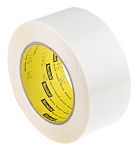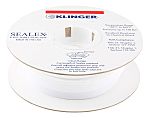
|
What is PTFE tape?
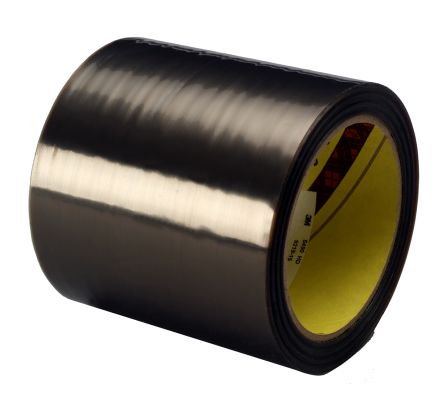
PTFE tape, often referred to casually as thread seal tape or ‘plumber’s tape’, is a simple but highly versatile thread sealant and lubricating material, used primarily in piping and ductwork applications.
Much like all types of professional adhesive tapes, it’s usually sold pre-cut to a range of specified widths on small rolls or spools. Plumber’s seal tapes sometimes come in a plastic cover or casing, to protect and preserve the adhesive material better during toolbox storage.
PTFE stands for polytetrafluoroethylene, which is a bit of a mouthful, but plumber’s tape is essentially a long strip of synthetic polymer film sold on a spool. Among PTFE’s key material characteristics are the fact that it’s both extremely low friction, and is hydrophobic (meaning it repels water). This makes PTFE tape incredibly useful for a wide range of plumbing and pipework jobs - which is why you’ll find a thread seal tape of some kind in almost every well-stocked plumbing or pipework toolkit.
But what exactly is plumber’s tape designed for, and which different varieties can be used for which specific tasks?
In this guide, we’ll take a closer look at a some of the main properties of PTFE thread sealant and lubrication tape, explore what it should and shouldn’t be used for, and outline a few of the most popular varieties of PTFE tapes for sale in the UK and beyond.
PTFE tape vs Teflon tape
You may see PTFE plumber’s tape being casually referred to as ‘Teflon™ tape’ in some situations, but this isn’t technically accurate. Teflon™ is a highly specific brand of material that - while chemically and functionally identical to PTFE - is actually no longer manufactured in tape form by the current trademark holder.
Therefore, strictly speaking, there is no such thing as Teflon™ thread sealing tape sold on today’s market. By contrast, true PTFE tape is widely available.
PTFE tape properties
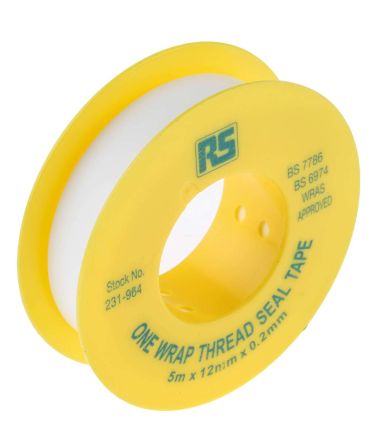
As previously mentioned, one key characteristic of PTFE thread seal tape is that it’s water-repellant, which makes it ideal for use in a wide range of plumbing and ductwork applications.
Another of its most prized qualities is that it’s a very low friction material, which is why it’s very often used mainly to lubricate joint threads in piping: a layer of PTFE tape around the threads of a joint can make it much easier to screw more tightly together, and to uncouple the mating parts later on.
Specific types of plumber’s tape may also boast any number of other important qualities which make it even better suited to particular tasks or environments. Depending on the brand and intended purpose, certain varieties of quality PTFE tape may feature any of the following properties:
-
-
Chemically inert, meaning it won’t react with other elements - this makes it suitable for more aggressive environments where acids, gases or solvents may be present
-
Robust pressure resistance - this makes it suitable for use in high bar applications, such as fuel injection systems
-
High temperature performance and high arc resistance - this makes certain tapes ideal for use with high-temperature coils, capacitors, and wire harnesses
-
Malleable and non-hardening - this makes PTFE tape ideal for winding easily around pipe threads, compression joints, radiator valves, taps and other fittings
-
Non-stick backing - this makes it easy to remove or reapply later, without having to clean messy adhesive from the inside surfaces of pipe threads and duct joints
-
Is PTFE tape oil and petrol resistant?
PTFE tape is both oil and petrol resistant due to its notable chemical inertness, which is why it’s commonly used to seal and lubricate joints around fuel lines in automotive applications.
Plumber’s sealing and lubricating tape also copes particularly well under the rigours of fairly high heat demands (see temperature performance section below) and high pressure, further underlining its suitability for use in environments where it’s likely to be exposed to oils, petrols, diesel and other fuels.
As with most applications of PTFE tape, it’s considered good practice to begin wrapping slightly below the first line of threading, such that you leave one full circumference of thread exposed at the insertion end of the mating joint.
In the event that any small pieces of PTFE tape are sheared off where the threads bite together, starting your wrap slightly back from the endpoint will prevent these tiny scraps of material from making their way into fuel lines or connected tanks.
PTFE tape temperature rating
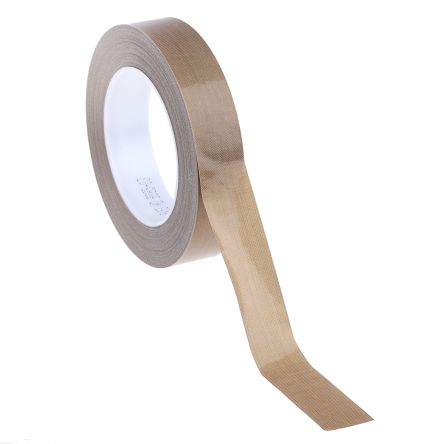
Different formulations and brands of plumber’s tape will typically have different temperature ratings, but the majority cover a fairly wide range of operating conditions.
The minimum safe operating temperature for PTFE tapes is around -200 Celsius, while the upper limits of heat performance tend to be at around +260 Celsius. PTFE itself has a high melting/decomposition point (of around +327 Celsius), but it begins to deteriorate as temperatures rise through the +200 to +260 Celsius range.
Not all thread seal tapes will be able to withstand this full array of safe operating temperatures - plumber’s tapes intended for use in high-temperature applications will be marked as such. Always check the specified heat rating in the product information provided by the supplier and manufacturer.
If you’re unsure about the temperature demands of a given thread seal tape or application environment, please feel free to contact our expert advice team for further product-specific assistance.
PTFE tape uses
When figuring out precisely what plumber’s tape is used for, it’s important to note that there are various different potential PTFE tape uses, depending on the specific needs of the job in hand.
PTFE tape is commonly referred to as a thread ‘sealant’, and indeed many types can help to minimise leakage around certain types of joints. Specific thicknesses of tape can be selected that will provide an additional barrier to leakage in ducting - these tapes often feature inherently expansive properties, helping to fill out any small gaps between threads and conduits once they’ve been wrapped around the inside of a threaded joint.
PTFE tape for leaks |
Although it can be a moderately effective short-term solution in a tight spot, using plumber’s tape as a temporary measure against existing leaks - which is generally done on the outside of a joint until further work can be carried out - it’s not viewed by professionals as an appropriate longer-term fix for damaged, degraded or incorrectly fitted joints. |
PTFE tape for gas |
Gas-rated PTFE thread seal tape is widely available, but it tends to be thicker and denser than standard PTFE tape for use in liquid plumbing environments. The latter can be prone to degradation and leaking if used inappropriately for gas pipelines, as it tends to be more porous. This is usually as a result of having been stretched thinner during the manufacturing process than the more heavy-duty PTFE tapes for natural gas ducting joints |
Oxygen PTFE tape |
Oils and solvents usually present in standard PTFE plumber’s tape as a result of the manufacturing process can cause volatile reactions in very oxygen-rich environments. Therefore, it’s crucial to use only fully oxygen-rated PTFE tapes for sealing and lubricating joints in oxygen lines. If the supplier’s documentation shows that a PTFE product is rated safe for use in oxygen-rich applications, it means the tape will have been passed through strict additional processing stages to remove oils and solvents from the finished product. Again, these tapes also tend to be denser and considerably less porous than most standard ‘plumber’s tape’ for use in water conduit. |
How does PTFE tape work?
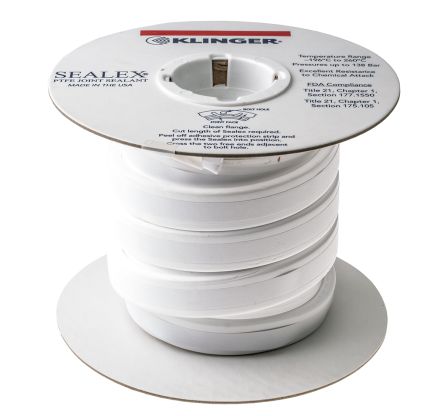
PTFE thread seal tape works by creating a tight-fitting seal or ‘skin’ around the threads of various joint types in piping and ductwork.
Proper application of PTFE tape, therefore, can allow the threads on a pipe joint to be mated more tightly together, and in most cases should prevent them from seizing up if you need to unscrew them at any point in future.
How to use PTFE tape
Applying plumber’s tape to joint threads is a simple process - but, as with many such everyday DIY jobs, there’s a knack to it. Following the general codes of best practice on using thread seal tape outlined below should yield reliable results every time.
How to apply plumbing tape
When applying thread tape, the first and most crucial job is always to make sure that you’re using the correct sort of PTFE tape for the application and setting you’re going to be putting it to work in.
Once that has been confirmed, you should then take care to follow these relatively straightforward steps in order:
-
First, clean the threads of the duct joint you’re going to be applying the PTFE tape to. Existing pipes will likely have traces of dirt, rust, grease or other pipe sealant left on them from previous applications. In the case of brand new lengths of conduit, the threads may not have been cleaned thoroughly after machining, meaning there could be metal shavings or factory oils present that will negatively impact on the integrity of the seal formed. It’s possible that you may need a specialised product such as an industrial-strength pipe cleaner to fully remove some stubborn or harsh solvents and greases.
-
Allow the cleaned threads of the joint to dry out very thoroughly before attempting any further work on them. This can usually be achieved with the conscientious use of paper towels, but it’s also wise to leave them out to fully air-dry if you can. Either way, you must be sure that no beads of moisture remain in even the tightest channels between or around threads that will be mated together.
-
Once the fittings are completely dry, you can begin wrapping your PTFE sealant tape around the threads. Start one thread down from the open end, to prevent any scraps of material sheared off during mating from entering the duct. Wrap in the same descending direction as the threads, working your way back towards the pipe - this is key to preventing unhelpful distortions, such as concentrated bunching or unravelling of the tape, as the opposing ends of the joint come together.
-
As you work your way down the threads, you should overlap the layers of tape by about half their width to ensure full coverage all the way around. It’s important not to use too much; again, while some deformation of the material between threads is helpful in creating a tighter seal, too much distortion can end up having the opposite effect. As you wrap, pull tightly enough to maintain sufficient tension such that the threads remain clearly visible as defined ridges, even through thicker or more opaque tape varieties.
-
Continue in this manner until you reach about one full wrap past the bottom of the last thread. Finish the final wrap by cutting and sticking down the final inch or so, making sure no loose tape is left hanging or improperly adhered, and the cut off end is pressed down as smoothly and seamlessly against the rest of the wrapping as possible.
-
Product spotlights
There are numerous sorts of PTFE plumber’s thread seal tape available on today’s market, and the ideal variety for use any given environment or setting should be assessed on a case-by-case basis. As with all such DIY and professional work products, certain brands offer particular qualities and strengths in particular areas or applications, click on the buttons below to see the whole range.
